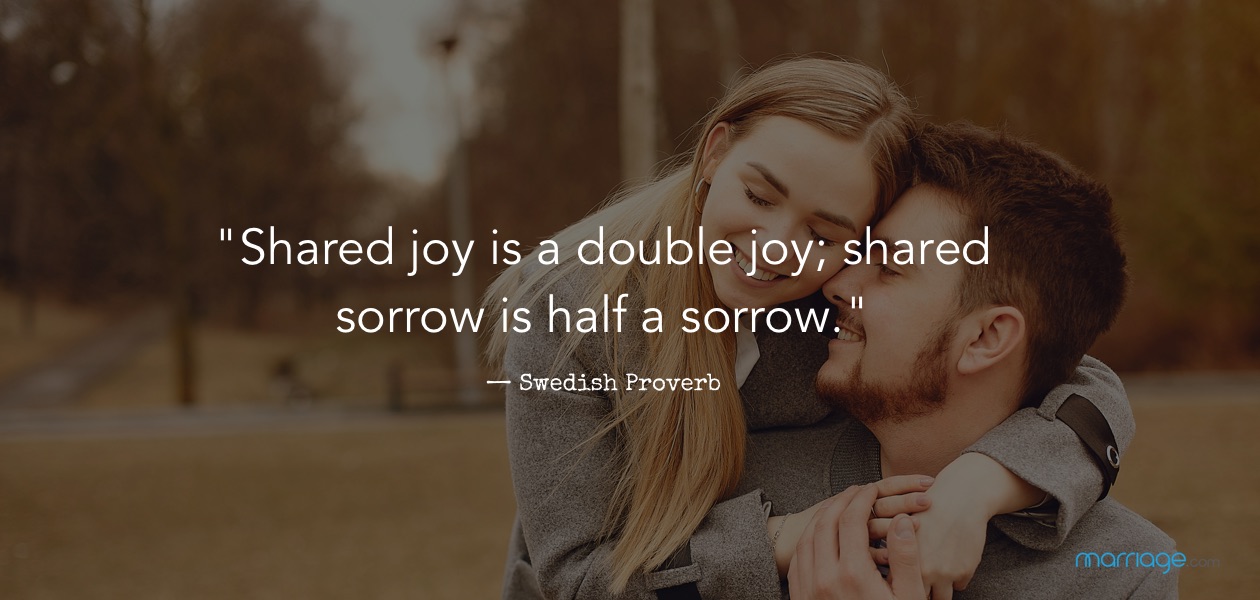
In the complexities of human existence, one of the most profound observations we can make is the way in which shared experiences shape our lives. The old adage, “shared joy is a double joy; shared sorrow is half a sorrow,” captures a fundamental truth about the human condition. It speaks to the essence of our social nature, suggesting that happiness increases when shared, while sorrow diminishes in the company of others. In this article, we will explore the depth of this wisdom, examining its relevance in various aspects of life, from personal relationships to professional environments.
The Social Fabric of Human Happiness
Joy and Connection: The Power of Shared Experiences
Happiness, in its purest form, is an emotion that thrives on connection. When we experience joy, whether through personal achievements, relationships, or simple pleasures, the natural impulse is to share it with others. This sharing amplifies the emotion, creating a sense of community and belonging. The laughter of friends, the pride of a family in a member’s success, or the collective excitement of a team reaching a milestone—all these instances demonstrate how joy multiplies when it is shared.
Psychological studies have consistently shown that people who share their positive experiences with others report higher levels of happiness. The act of sharing joy does more than just spread the good feelings; it reinforces the social bonds that are crucial to our well-being. These bonds, in turn, create a support network that can cushion us in times of sorrow, underscoring the reciprocal nature of sharing emotions.
Shared Sorrow: The Balm of Empathy
Just as joy is amplified when shared, sorrow is mitigated through the empathy and understanding of others. Grief, disappointment, and sadness are burdens that can feel overwhelming when borne alone. However, when we share these emotions with others, especially those who empathize with our situation, the weight of our sorrow becomes more manageable.
Empathy is a powerful tool in emotional healing. It allows us to feel understood, validated, and supported. When others listen to our troubles, offer comfort, or simply stand by us, they help us carry the load, reducing its impact. This process of shared sorrow does not erase the pain, but it does transform it, making it easier to cope with and eventually overcome.
The Role of Shared Experiences in Building Stronger Relationships
Strengthening Bonds Through Shared Joy
At the heart of any strong relationship—be it between friends, family members, or colleagues—is the ability to share in each other’s joys. Celebrating successes together, no matter how small, creates a positive reinforcement loop that strengthens the relationship. These shared moments of happiness build trust and mutual respect, essential ingredients for any lasting bond.
In romantic relationships, for example, couples who frequently share positive experiences are more likely to report higher levels of satisfaction. The simple act of expressing happiness and celebrating achievements together enhances the emotional connection between partners, fostering a deeper sense of intimacy and trust.
Healing and Resilience Through Shared Sorrow
Just as joy can strengthen relationships, shared sorrow can bring people closer. When individuals support each other through difficult times, they build a foundation of trust and resilience. This is particularly evident in families or close-knit communities, where collective grieving and mutual support play a crucial role in overcoming tragedies.
In the workplace, shared sorrow can also be a catalyst for team cohesion. When a team faces setbacks or failures, the collective response to these challenges can determine the strength of the group. Teams that openly share their disappointments and work together to overcome obstacles are often more resilient and better equipped to handle future challenges.

The Neuroscience Behind Shared Emotions
The Brain’s Response to Shared Joy
Neuroscience offers fascinating insights into why shared joy is so powerful. When we share positive experiences, our brains release dopamine and oxytocin, chemicals associated with pleasure and bonding. These neurochemical responses reinforce the positive emotions associated with sharing, making us feel even happier and more connected to those around us.
Studies have shown that even the anticipation of sharing a joyful experience can trigger these responses. The act of storytelling, for example, can elicit feelings of joy in both the teller and the listener, as they engage in a shared emotional experience. This biological basis for shared joy underscores the importance of social interactions in our overall happiness.
The Alleviation of Sorrow Through Social Support
The brain also plays a significant role in how we experience and alleviate sorrow. Social support has been shown to activate regions of the brain associated with stress reduction. When we share our sorrows, particularly with those who are empathetic, our brains produce endorphins—natural painkillers that help ease emotional distress.
Moreover, the presence of social support can reduce the production of cortisol, a stress hormone. This reduction in stress levels not only helps mitigate the emotional impact of sorrow but also has tangible health benefits, such as improved immune function and better mental health outcomes.
Cultural Perspectives on Shared Joy and Sorrow
Western Views on Emotional Sharing
In Western cultures, there is a strong emphasis on individualism. However, even within this context, the value of shared joy and sorrow is widely recognized. Celebrations, such as weddings, graduations, and holidays, are communal events where joy is shared and multiplied. invitation printing can add a personal touch to these special occasions. Similarly, funerals, memorial services, and support groups provide spaces for collective mourning, where sorrow is acknowledged and shared.
These cultural practices highlight the universal need for connection, even in societies that prioritize individual achievement. The rituals of sharing both joy and sorrow serve to strengthen community bonds and ensure that individuals feel supported and valued within their social networks.
Eastern Emphasis on Collective Emotion
In contrast, many Eastern cultures place a stronger emphasis on collectivism, where the sharing of emotions is deeply ingrained in social practices. In these cultures, the concept of shared joy and sorrow is often linked to the idea of interconnectedness—the belief that individual emotions are tied to the collective well-being.
For example, in many Asian cultures, family and community are central to the individual’s emotional life. Joyous occasions are celebrated collectively, with the understanding that happiness is a communal resource. Likewise, during times of sorrow, the community comes together to provide support, emphasizing the shared nature of emotional experiences.
Practical Applications: Enhancing Personal and Professional Relationships
Fostering Shared Joy in Personal Life
To cultivate shared joy in our personal lives, we must actively seek opportunities to connect with others in meaningful ways. This can be as simple as celebrating small victories with friends or taking the time to share positive news with loved ones. By prioritizing these moments of shared happiness, we strengthen our relationships and create a more joyful life.
Building Resilience Through Shared Sorrow
Similarly, embracing shared sorrow involves creating spaces where we can express our emotions without fear of judgment. Whether through open conversations with friends and family or participating in support groups, sharing our burdens helps us build resilience and find comfort in the presence of others.
Creating a Culture of Shared Emotions in the Workplace
In professional settings, leaders can foster a culture of shared emotions by encouraging transparency and open communication. Celebrating team successes together and acknowledging collective setbacks can enhance team cohesion and build a supportive work environment. By recognizing the value of shared joy and sorrow, organizations can create a more connected and resilient workforce.
Conclusion: The Timeless Wisdom of Shared Emotions
The saying “shared joy is a double joy; shared sorrow is half a sorrow” is more than just a proverb; it is a guiding principle for living a fulfilled life. By embracing the power of shared emotions, we can build stronger relationships, enhance our well-being, and create a more connected and compassionate world. Whether in our personal lives or professional environments, the act of sharing both joy and sorrow enriches our experiences and helps us navigate the complexities of life with greater ease and grace.






